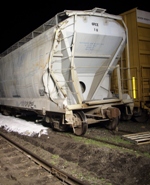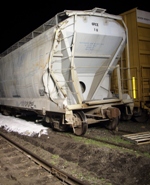
The Lifecycle of Hazardous Waste
- By Geoffrey Brown
- Jul 05, 2010
What happened: While in transit through a railyard in Massachusetts, a freight car filled with sodium chlorate struck an adjacent tank car, causing a massive release of up to 20,000 pounds of the chemical. The moving tank car released a stream of sodium chlorate over a span of more than 2,000 feet – spreading the material across the rail yard and near the neighboring, active Massachusetts Bay Transit Authority (MBTA) commuter rail line.
The danger: The chemical compound sodium chlorate is used most commonly as a main component of chlorine dioxide, today’s most predominant bleaching agent. The compound is a strong oxidizer and therefore carries a risk of fire and explosion when mixed with other substances, especially organic materials. Like many similar products, sodium chlorate is transported across the US primarily via railroad.
The assessment: Railyard workers knew they needed to act fast to report the spill and begin cleanup. Among those notified included local police, fire, and hazmat responders, and the Massachusetts Department of Environmental Protection (MassDEP), U.S. Environmental Protection Agency, Licensed Site professional Environmental Resources Management (ERM), and ENPRO Services, Inc., a locally based environmental cleanup firm experienced in hazardous waste remediation.
The first step was to quickly recover the visible, crystalline sodium chlorate. The sodium chlorate had been released on and adjacent to the tracks, and thus was in direct contact with creosote-treated wooden railroad ties, leaves, wind-blown debris, and other organic matter. On site responders were very concerned that the strong oxidizer might react with these organic materials, leading to fire that could damage the railroad track, hundreds of staged railcars, and potentially adjacent buildings and the MBTA rail line. Because of the location of the release, ENPRO personnel had to use hand tools, including specialized vacuum cleaners, to recover the sodium chlorate. ENPRO personnel attempted to segregate the chemical from the organic matter, but in some instances this was impossible, as the sodium chlorate was mixed with oil-impacted soil or embedded in cracks and fissures in oil- and creosote-impacted railroad ties.
The bulk of the sodium chlorate was recovered within 36 hours of the spill.
An important step in the cleanup was to identify any protected areas or environmentally sensitive receptors nearby which had the potential to be affected by the spill. Crews researched and confirmed that no Zone II Wellhead Protection Areas, Interim Wellhead Protection Areas, Potentially Productive Aquifers, or private wells were located within 500 feet of the site. Additionally, workers ascertained that no Areas of Critical Environmental Concern or Habitats of Rare Wetlands Wildlife were near enough to the spill to be endangered.
The action: The sodium chlorate recovered from the railroad tracks was staged in waste packs, triple-lined with polyethylene liners, pending determination of suitable disposal facility. Because of concerns regarding the presence of the organic matter that could not be separated from the sodium chlorate, the containerized waste was staged in a remote area at the railyard. The following day, as cleanup continued, the staged waste sodium chlorate reacted and caught fire, requiring a response from the local fire department and the establishment of a round-the-clock fire watch. After the fire, the site was monitored for flare-ups; water was used to saturate the release area during periods of hot weather, and no further substantial incidents occurred.

Sodium chlorate was released to the tracks when the rail car carrying the chemical struck a stationary rail car. The sodium chlorate was then spilled over 2,000 feet as the train came to a stop.
ERM and ENPRO scientists, in consultation with the MassDEP determined that the application of a 5 percent sodium thiosulfate solution was the best approach to take to neutralize the impacted soil in the rail yard. Approximately 11,250 pounds of sodium thiosulfate was mixed with approximately 17,250 gallons of water in a 20,000-gallon fractionation tank, and then transferred to 1,000-gallon totes on rail cars for transport to the impacted area. After application, remediation crews monitored the neutralization process by measuring the change in temperature as well as oxygen, chlorine, and sulfate levels. An additional application of the solution was necessary to ensure full neutralization, as confirmed by analysis of field samples in a certified Massachusetts laboratory.
Approximately 50 tons of remediation waste were generated at the site and transported along with wetted fire-related waste to the Stablex Canada Inc. (Stablex) hazardous waste disposal facility in Blainville, Quebec. Non-impacted sodium chlorate that was offloaded from the damaged tank car was also transported to Stablex. The final transport of material involved the remainder of the response action waste, including drums with personal protective equipment. These materials were transported to the ENPRO facility in South Portland, Maine, for disposal. ENPRO utilized hazardous materials transportation management software made by its subsidiary, Terralink, to ensure proper documentation of the remediation waste transport.
The waste was moved off-site within one week of the spill and the majority of chemical treatment was completed within 2 months (including approximately 1 month to receive regulatory approval for treatment methodology.) The cleanup firm will submit the final closure report within 1 year of the spill.
The result: Due to the spill’s potential to impact the railyard, hundreds of rail cars, and the adjacent MBTA Commuter Rail, this high-profile release required rapid initial response and subsequent thorough remediation. By working seamlessly together, the companies and local authorities were able to quickly close out the site with MassDEP.
About the Author
Geoffrey A. Brown, Ph.D., is a vice president and has worked at ENPRO since 1998. Brown specializes in the assessment and remediation of complex oil and hazardous material release sites. He has more than 20 years of experience in the environmental field, with both environmental consulting/contracting firms and the Massachusetts Department of Environmental Protection. Brown holds a doctorate in soil science from Cornell University.